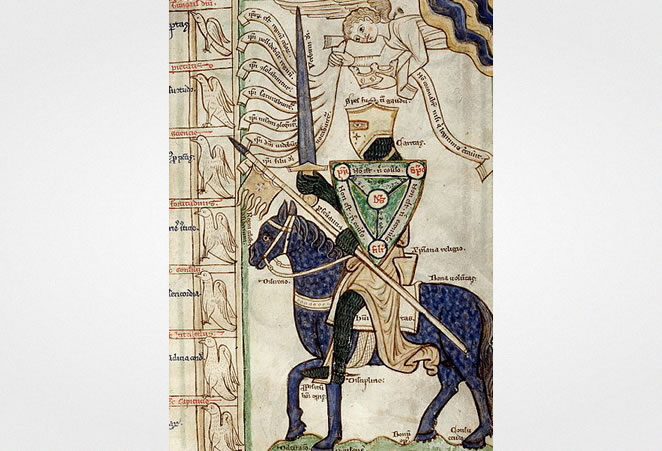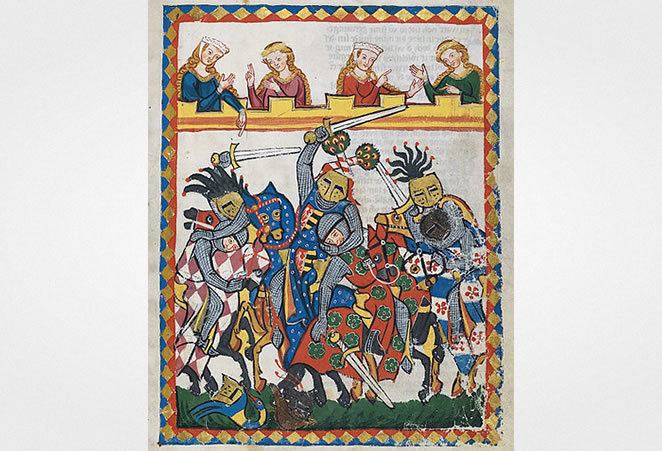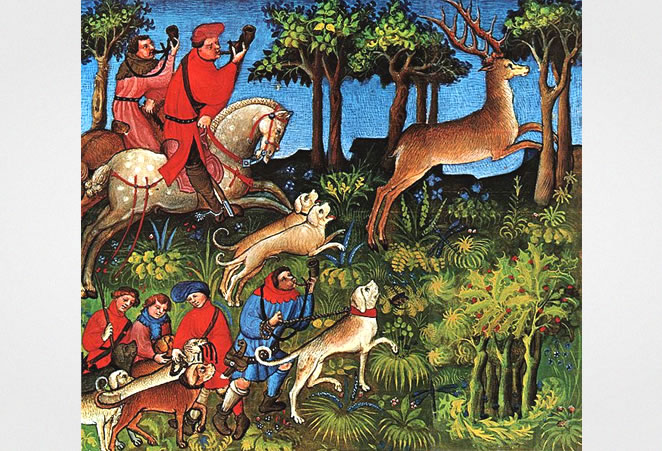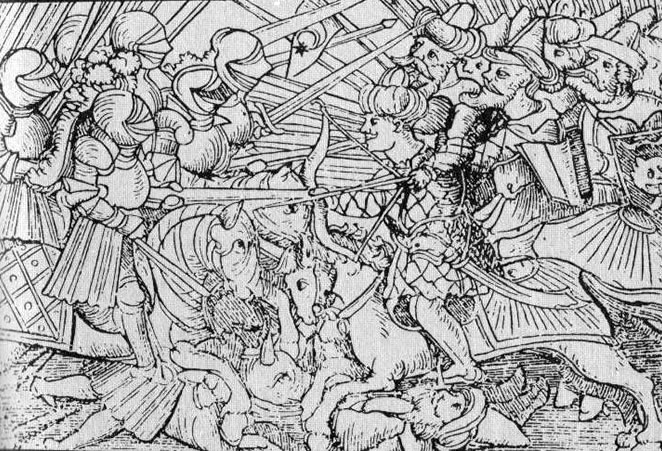Who were knights
Knighthood emerges in Europe with the appearance of feudalism, and it is mostly developed between the 11th and 13th century.1 Already during the Carolingian period, there was a substantial increase of cavalry in the military, and they were paid for their service inland properties. Warriors were thus given land, and in return, they fought for the ruler and swore him their allegiance. They were given authority to collect taxes from their serfs, and they were also exempt of some of the feudal tributes. All of these warriors, that owned properties and were subordinate and loyal to their seigneurs, who granted them land, were called knights.2
A knight’s training usually started already at the age of seven, when a boy that was decided to become a knight was sent to a kinsman, also a nobleman, to serve as a page. There he was taught the skills of warfare, and riding, but also mannerliness and politeness. At the age of fourteen, he would have become a squire, becoming a servant to some other knight. There he was taught sword handling and was also responsible for grooming the horse and taking care of the armour and weapon of the knight that he served. Young squires had to be in great physical shape. That is why they regularly trained, fighting each other. Those training were tough and exhausting, so only some of them were able to finish. The squire accompanied the knight in tournaments, and even in battles, in which he helped him in preparations and armouring.
If he should successfully pass the training, a young man at the age of twenty-one was subsequently proclaimed a knight, in a grand ceremony held in his honour. In this ceremony, before the proclamation, he was obliged to demonstrate his skills in front of the guests.3 The inauguration was particularly solemn; it started by putting on the armour in the presence of the godfather, who was in most cases, an intently chosen close relative.4 Then, he was awarded a weapon and special marks of knighthood, a belt, golden spurs and a crest with a motto. The Prentice pledged an oath by which he committed loyalty and bravery to his seigneur (a count, a duke or a ruler). A strike of a sword upon the shoulders and the head marked that he had become a knight.5
Knights equipment
Since having fought on a horse, every knight had to have at least one in his possession. It served him in warfare, tournaments, travel, and equipment transfer. Horses were then particularly expensive, and the most valuable were the ones from Italy, France and Spain.6
As to protect themselves from hits during the battle, knights wore armour. In the beginning, these armours were mails consisting of many small, tied metal rings. A single mail shirt used to weigh between nine and fourteen kilograms.7 In the 15th century, plate armour was introduced. Although it was often considered heavy and stiff, thereby inconvenient to wear, this was not true. The armourers that built these armours made them prudently so to enable the knight to move as quickly as possible while wearing them. The secret was in the workmanship of the plates, which were able to move along with the knight’s body. They were linked with rivets that enabled them to move.8 The armour could have been put on and taken off in a matter of minutes, and his squire aided the knight.
The most important weapon the knights carried was a sword, which changed its shape through time, depending on whichever armour was popular. Apart from swords, the knights also occasionally wore an axe, a spear, a dagger, a bow, etc.
Although the rules of knighthood implied that the winners in battle had to be courteous to the defeated, this, however, did not apply to their equipment. Thus, they regularly plundered horses, weapons and armours from their rivals after the battle, which presented a significant portion of their incomes.9
Knights tournaments
Besides the battles, knights also fought in tournaments, which appeared in the 11th century, and apart from serving as entertainment for the spectators, they were also a kind of practice ground for warfare. In a fake battle that was organized within a tournament, two teams would oppose each other. After its finish, the defeated had to give up their horses and armours to the victors. Some other forms of competitions, such as knights duels or standing up fights, were also held.10
Knights duels in which two knights fight with lances riding on horses appeared in the 13th century. Knights would run towards each other at a fast speed, with the primary aim to strike the opponent with the lance, thus unhorsing him. At first, they used sharp lances, which were later replaced by blunted ones. Such fights with blunt lances were called „the peace duels“. A wooden fence was introduced in the 15th century, which disparted the knights’ tracks, and it also prevented the possibility of a collision.11 After the duel using lances, the fight could have been continued on foot, and the knights would continue to fight using swords, axes or a club. Every contestant had a certain amount of hits that he was allowed to direct at his opponent. During the duel, armed men stood in the vicinity to the contestants, ready to separate them if they got carried away.12
There were also waterborne knights duels, in which the conflicting knights were distributed into two boats. The teams would paddle towards each other, and in the prow, there was a knight that was trying to unbalance his opponent by hitting him with a lance.13
However, not all of the duels were competitive, since sometimes murder or treason accusations were solved by fighting. It was considered that God would aid whoever was genuinely innocent. Thus the fights lasted until one of the contestants would be killed or surrender, after which he would nonetheless be punished by death.14
Hunting
Hunting was one of the favourite hobbies of then nobility, especially knights. It was also a good exercise for warfare and especially useful for practising the use of bow and arrows. Also, it provided fresh meat, and it served as a place of social gathering, so it was especially popular amongst the members of the noble class. Hunters used bows or arbalests, and they hunted all sorts of game, from deers, boars, rabbits, to different types of birds. Particularly popular was falconry, which was so favoured by the German emperor Friedrich II Falconer that in the middle of the 13th century he wrote a book on that topic. Hunters were also primarily aided by specially trained hounds, of which they took special care. In the events of injuries, the dogs were treated with healing herbs and were also successfully treated from bone fractures and dislocations.15
The end of knighthood
Around 1500, there is a change in the structure of previous military units. An essential part of all armies becomes well-trained disciplined infantry, which gradually suppresses the heavily armed and armoured cavalry. There is a change in the recruitment process, as well. The recruits are now mostly well-trained professional mercenaries, and there is less and less need for knights, who become ineffective in the battlefield as well. The appearance of firearms is also not to be omitted since it has proven to have a fatal and very devastating effect on the knight’s armour.
Knighthood seized to be a title carried from father to son in the 16th and 17th century. It instead became just a spoken honour which a ruler awarded to people whom he wished to give tribute to. It, however, had no relevance to warfare whatsoever.
Related articles:
- Knights were medieval warriors of noble descent, who fought on a horse.
- Their training began already at the age of seven, when they were sent to some of their relatives who were also knights of noble lineage, to serve as pages.
- The ceremony of inauguration of knights was particularly solemn, and the highlight was laying sword upon the head and the shoulders of the future knight, by his lord.
- Favorite hobbies of knights in the times of peace were hunting and falconry.
- Dora BOŠKOVIĆ, Damir DORAČIĆ, Mačevi viteškog doba u Hrvatskoj, Hrvatski povijesni muzej, Zagreb, 2009
- Christopher GRAVETT, Vitez, Knjiga svijeta, Zagreb, 1997
- Boško ŠILJEGOVIĆ, Vojna enciklopedija, Izdanje redakcije vojne enciklopedije, Beograd, 1960, volume 9, – viteštvo [Milivoje NIKOLIĆ]
- 1 Boško ŠILJEGOVIĆ (ed.), Vojna enciklopedija, Izdanje redakcije vojne enciklopedije, Beograd, 1960, volume 9, – viteštvo</> [Milivoje NIKOLIĆ], 575
- 2 Christopher GRAVETT, Vitez, Knjiga svijeta, Zagreb, 1997, 6
- 3 Christopher GRAVETT (note 2), 10-11
- 4 Dora BOŠKOVIĆ, Damir DORAČIĆ, Mačevi viteškog doba u Hrvatskoj, Hrvatski povijesni muzej, Zagreb, 2009, 15
- 5 Boško ŠILJEGOVIĆ (ed.) (note 1), 575
- 6 Christopher GRAVETT (note 2), 20-21
- 7 Christopher GRAVETT (note 2), 12
- 8 Christopher GRAVETT (note 2), 14-16
- 9 Christopher GRAVETT (note 2), 32-33
- 10 Christopher GRAVETT (note 2), 42
- 11 Christopher GRAVETT (note 2), 44
- 12 Christopher GRAVETT (note 2), 46
- 13 Christopher GRAVETT (note 2), 45
- 14 Christopher GRAVETT (note 2), 46
- 15 Christopher GRAVETT (note 2), 50-51




Medieval French had two words, chevaleresse and chevalière, which were used in two ways: one was for the wife of a knight, and this usage goes back to the 14th century. The other was possibly for a female knight. Here is a quote from Menestrier, a 17th-century writer on chivalry: “It was not always necessary to be the wife of a knight in order to take this title. Sometimes, when some male fiefs were conceded by special privilege to women, they took the rank of chevaleresse, as one sees plainly in Hemricourt where women who were not wives of knights are called chevaleresses.” Modern French orders of knighthood include women, for example the Légion d’Honneur ( Legion of Honor ) since the mid-19th century, but they are usually called chevaliers. The first documented case is that of Marie-Angélique Duchemin (1772–1859), who fought in the Revolutionary Wars, received a military disability pension in 1798, the rank of 2nd lieutenant in 1822, and the Legion of Honor in 1852. A recipient of the Ordre National du Mérite recently requested from the order’s Chancery the permission to call herself “chevalière,” and the request was granted (AFP dispatch, Jan 28, 2000).
I really enjoyed your site! As a medieval history teacher it is so difficult to find creditable content that is both informative and intriguing. My 7th graders are going to enjoy learning about the middle ages from the information that you have provided!